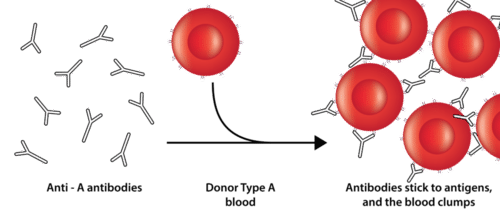11.27: Blood Type
- Page ID
- 14327

What's your type?
As this woman donates blood, you can see her blood collecting in a special bag. This bag is coded with her blood type. That makes it possible for doctors and nurses to match up the blood she is giving to a recipient that has the same blood type.
Blood Types
Do you know what your blood type is? Maybe you have heard people say that they have type A or type O blood. Blood type is a way to describe the type of antigens, or proteins, on the surface of red blood cells (RBCs). There are four blood types; A, B, AB, and O.
- Type A blood has type A antigens on the RBCs in the blood.
- Type AB blood has A and B antigens on the RBCs.
- Type B has B antigens on the RBCs.
- Type O does not have either A or B antigens.
The ABO blood group system is important if a person needs a blood transfusion. A blood transfusion is the process of putting blood or blood products from one person into the circulatory system of another person. The blood type of the recipient needs to be carefully matched to the blood type of the donor. That's because different blood types have different types of antibodies, or proteins, released by the blood cells. Antibodies attack strange substances in the body. This is a normal part of your immune response, which is your defense against disease.
For example, imagine a person with type O blood was given type A blood. First, what type of antibodies do people with type O blood produce? They produce anti-A and anti-B antibodies. This means, if a person with type O blood received type A blood, the anti-A antibodies in the person’s blood would attack the A antigens on the RBCs in the donor blood (Figure below). The antibodies would cause the RBCs to clump together, and the clumps could block a blood vessel. This clumping of blood cells could cause death.

People with type A blood produce anti-B antibodies, and people with type B blood produce anti-A antibodies. People with type AB blood do not produce either antibody.
The Rhesus Factor
The second most important blood group system in human blood is the Rhesus (Rh) factor. A person either has, or does not have, the Rh antigen on the surface of their RBCs. If they do have it, then the person is positive. If the person does not have the antigen, they are considered negative.
Blood Donors
Recall that people with type O blood do not have any antigens on their RBCs. As a result, type O blood can be given to people with blood types A, B, or AB. If there are no antigens on the RBCs, there cannot be an antibody reaction in the blood. People with type O blood are often called universal donors.
The blood plasma of AB blood does not contain any anti-A or anti-B antibodies. People with type AB blood can receive any ABO blood type. People with type AB blood are called universal recipients because they can receive any blood type. The antigens and antibodies that define blood type are listed as follows (Table below).
| Blood Type | Antigen Type | Plasma Antibodies | Can Receive Blood from Types | Can Donate Blood to Types |
|---|---|---|---|---|
| A | A | anti-B | A,O | A, AB |
| B | B | anti-A | B,O | B, AB |
| AB | A and B | none | AB, A, B, O | AB |
| O | none | anti-A, anti-B | O | AB, A, B, O |
Summary
- Blood type, which can be A, B, AB, or O, is a way to describe the type of proteins on the surface of red blood cells.
- Another important aspect of blood type is the Rhesus (Rh) factor; a person either has, or does not have, the Rh antigen on the surface of his/her red blood cells.
Explore More
Use the resource below to answer the questions that follow.
- Understanding Blood Types at http://www.youtube.com/watch?v=G_-9_CF02qI (2:12)
- What is an antigen? What are two examples of antigens?
- What is an antibody?
- What type of antigen are on type O red blood cells?
- What antibodies are produced by people with type O blood?
- What does type B blood have that type O blood does not?
Review
- What is an antigen?
- Why is it important to match blood types when giving a blood transfusion?
- Why are people with type O blood called "universal donors"?
- Who are universal recipients? Why?

